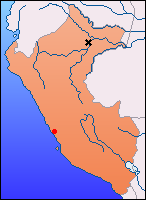 |
Associated pages: |
 Iquitos, the capital of the Loreto department, was founded in 1757 under the name San Pablo de los Napeanos, becoming the first major river port in the vast Peruvian Amazon region. The history of Iquitos is closely tied to the presence of Jesuit missionaries, who were the first to colonize these lands. The origin of the city dates back to 1740, when Jesuit priest José Bahamonde established the villages of Santa Bárbara de Nanay and Santa María de Iquitos along the Mazán River.
Iquitos, the capital of the Loreto department, was founded in 1757 under the name San Pablo de los Napeanos, becoming the first major river port in the vast Peruvian Amazon region. The history of Iquitos is closely tied to the presence of Jesuit missionaries, who were the first to colonize these lands. The origin of the city dates back to 1740, when Jesuit priest José Bahamonde established the villages of Santa Bárbara de Nanay and Santa María de Iquitos along the Mazán River.
As the population grew, the inhabitants decided to relocate to safer and more strategic areas along the Nanay River, and later to the plains along the Amazon, between the Nanay and Itaya rivers. This new location allowed them to better utilize the river’s resources and access key trade routes. Thus, the city of Iquitos was formed, which would soon become the gateway to the heart of the Amazon.
The Loreto department, characterized by its fast-flowing rivers and lush vegetation, was long inhabited by numerous nomadic and semi-nomadic tribes. These tribes, with their diverse languages and customs, lived in harmony with nature, relying on wild fruits, fishing, and hunting for sustenance. Many of these communities still survive today along the banks of the Amazon and its tributaries, preserving their ancient traditions.
 The first outsiders to venture deep into the Amazon rainforest were missionaries, who, in their quest for evangelization, founded numerous villages in the region. This intervention helped the local tribes integrate into a more Western way of life. However, the expulsion of the Jesuits in 1769 brought about a significant change in the lifestyle of these communities. After the Jesuits’ departure, contact with the outside world diminished temporarily, but trade between Peru and Brazil continued, particularly after Peru’s independence from Spain in 1821.
The first outsiders to venture deep into the Amazon rainforest were missionaries, who, in their quest for evangelization, founded numerous villages in the region. This intervention helped the local tribes integrate into a more Western way of life. However, the expulsion of the Jesuits in 1769 brought about a significant change in the lifestyle of these communities. After the Jesuits’ departure, contact with the outside world diminished temporarily, but trade between Peru and Brazil continued, particularly after Peru’s independence from Spain in 1821.
The real development of Iquitos came in the late 19th century with the famous rubber boom. From 1880 onwards, the city underwent a radical transformation, becoming one of the most important economic hubs in the Amazon region. This boom attracted entrepreneurs from around the world, who saw in rubber an inexhaustible source of wealth. Luxurious buildings, such as the famous Casa de Fierro, designed by Gustave Eiffel, and other structures still visible today, are a testament to the prosperity the city experienced during this period.
However, the collapse of the rubber market in the early 20th century had a severe impact on the local economy. Many of the entrepreneurs left the city, but they left behind a rich architectural and cultural legacy. Despite this crisis, Iquitos managed to reinvent itself by diversifying its economy, including the exploitation of other natural resources.
In 1936, oil exploration began in the region, bringing about a new era of economic development. Today, the Loreto department remains one of Peru's main oil producers, though this activity has also generated controversy due to its environmental impact. Besides oil, the Amazon region is rich in forest resources, and numerous projects are underway to ensure sustainable exploitation of these resources.
However, the unchecked exploitation of the forest has sparked debate about the need to preserve the Amazon ecosystem. Conservation and sustainable tourism projects have emerged as alternatives to protect the region’s biodiversity while allowing visitors to explore the jungle responsibly and learn about the rich flora and fauna that inhabit it.
Today, Iquitos has become one of the main tourist destinations in the Amazon. The city serves as the starting point for numerous jungle expeditions, allowing travelers to venture deep into the Peruvian Amazon. From river cruises along the Amazon to jungle treks and visits to indigenous communities, Iquitos offers a unique experience for those seeking to connect with nature.
One of the main attractions is the Pacaya Samiria National Reserve, the largest in Peru, home to an incredible diversity of animal and plant species. Visitors can spot pink dolphins, caimans, monkeys, and a wide variety of tropical birds. Additionally, Iquitos is known for its unique cuisine, which features local jungle ingredients such as paiche, the largest fish in the Amazon, and camu camu, a fruit rich in vitamin C.
With its rich history, unparalleled biodiversity, and strategic location in the heart of the Amazon, Iquitos remains one of Peru's greatest treasures, attracting adventurers and travelers from around the world.